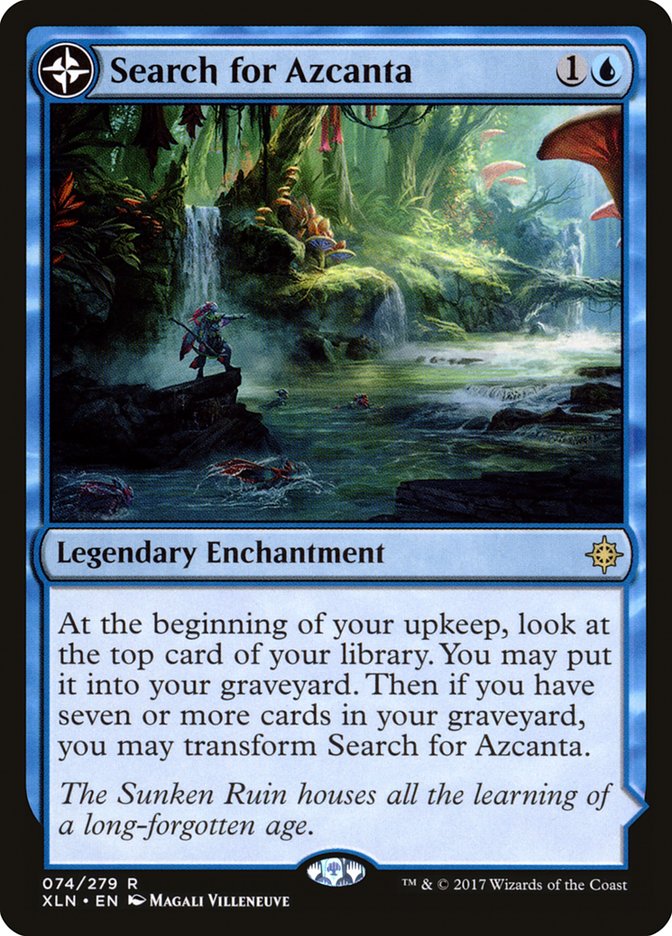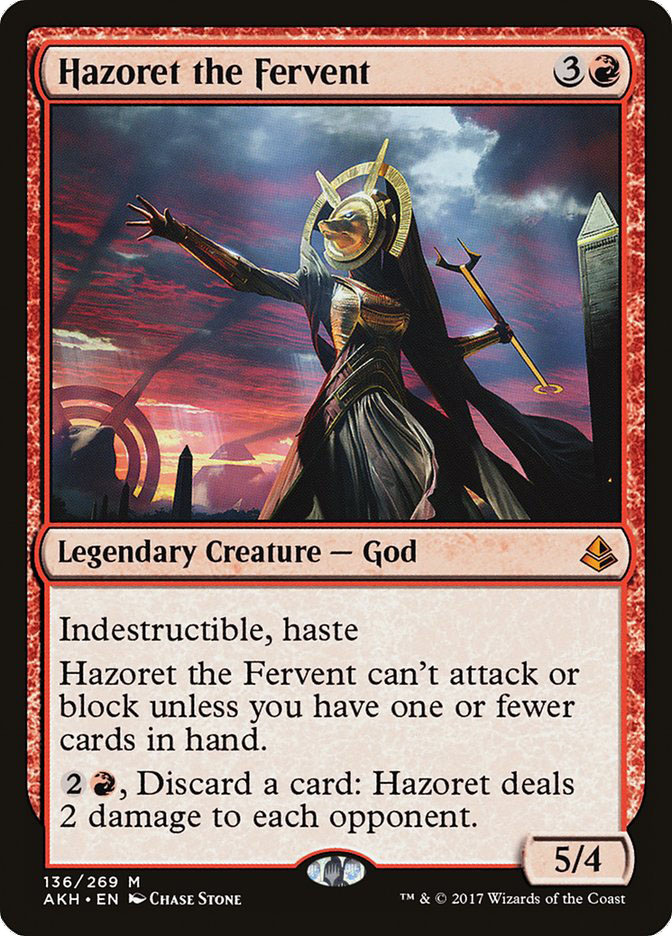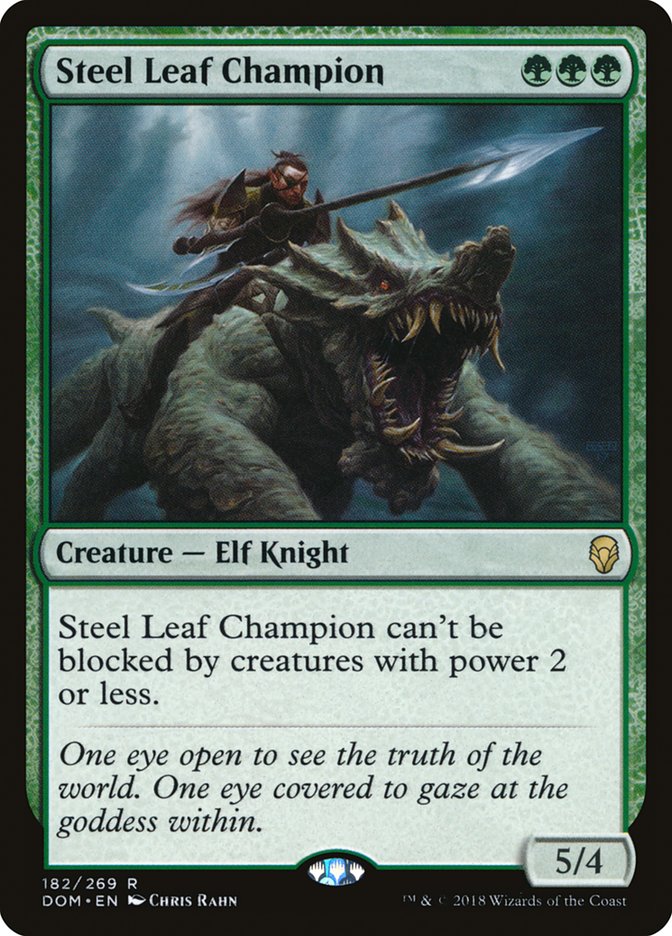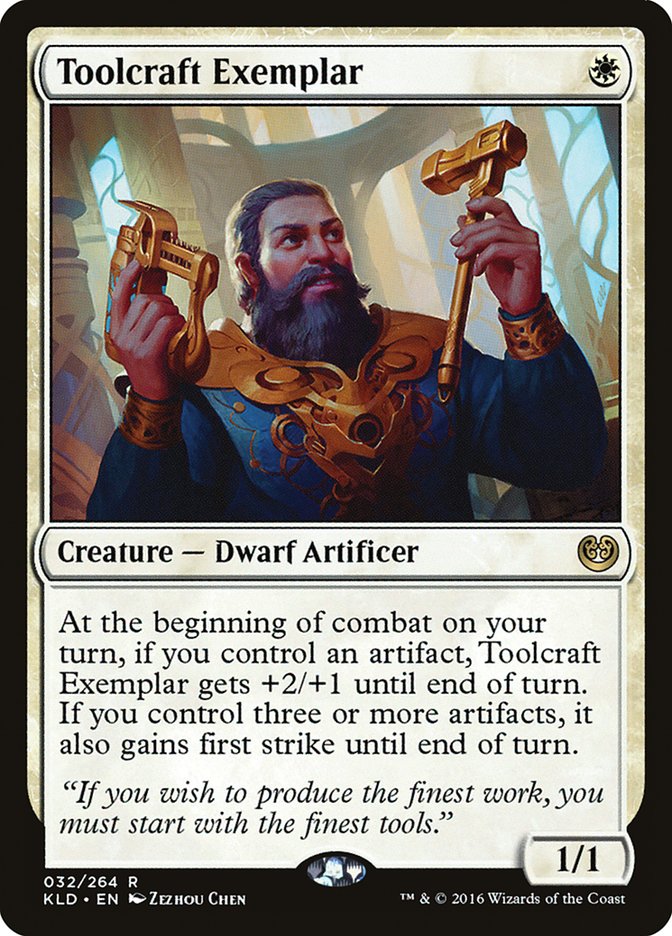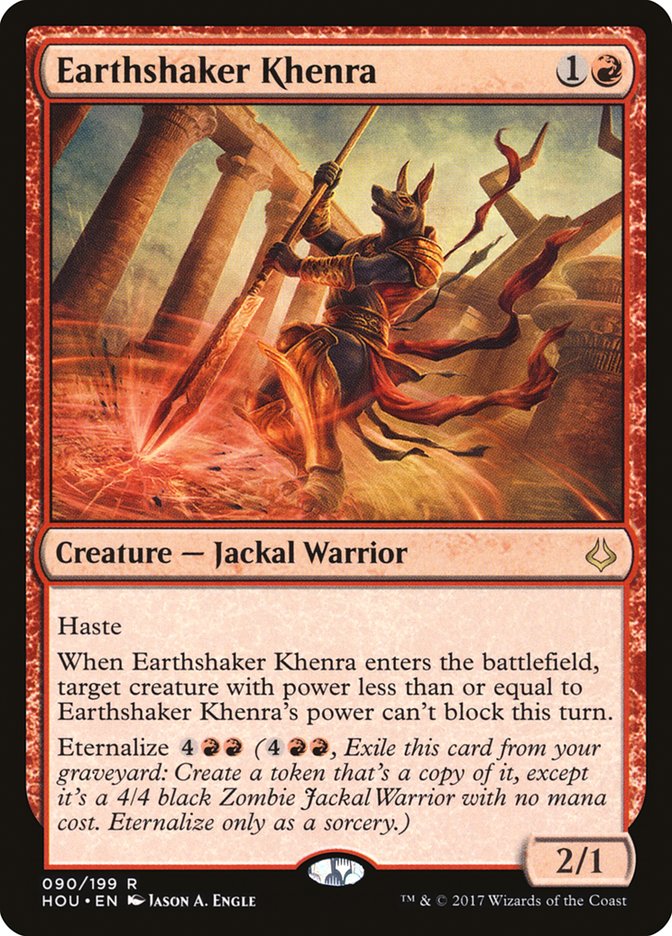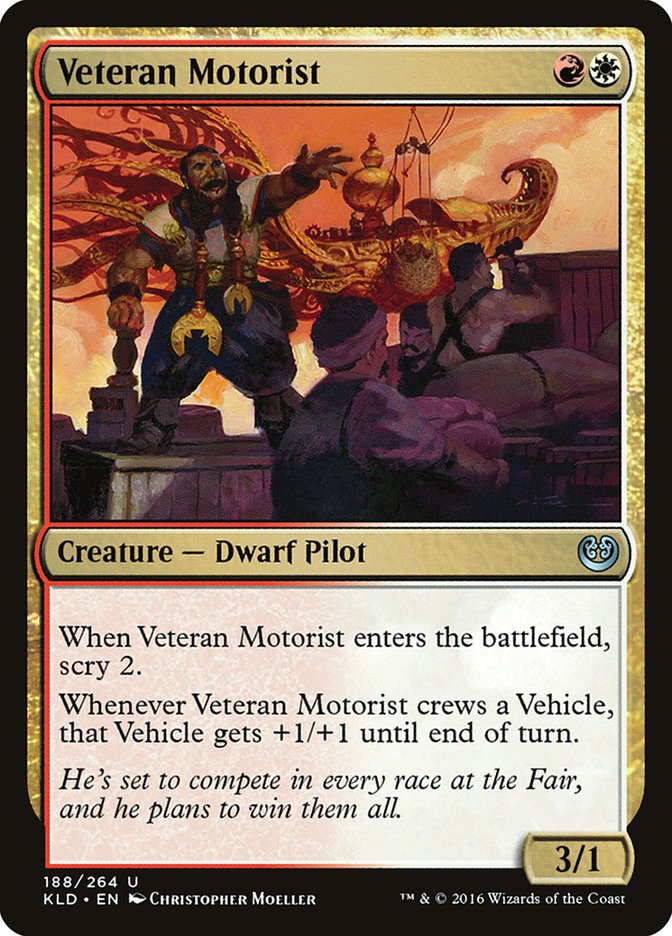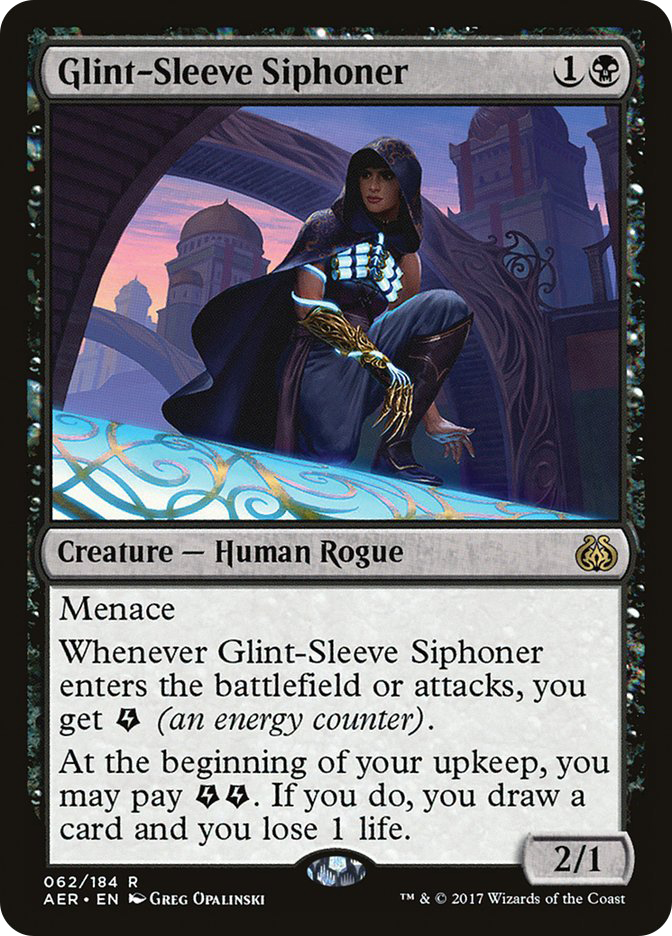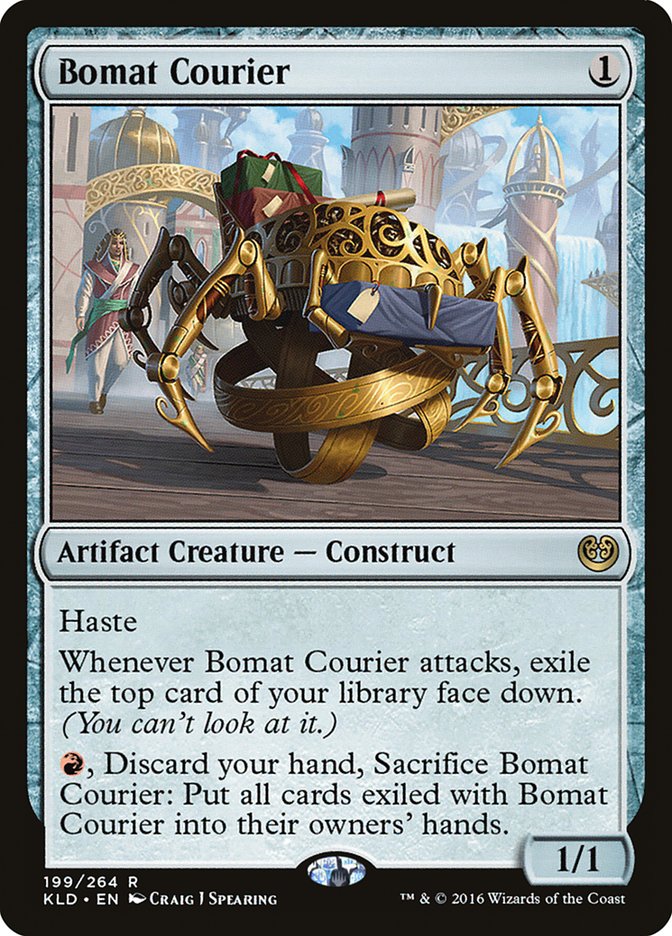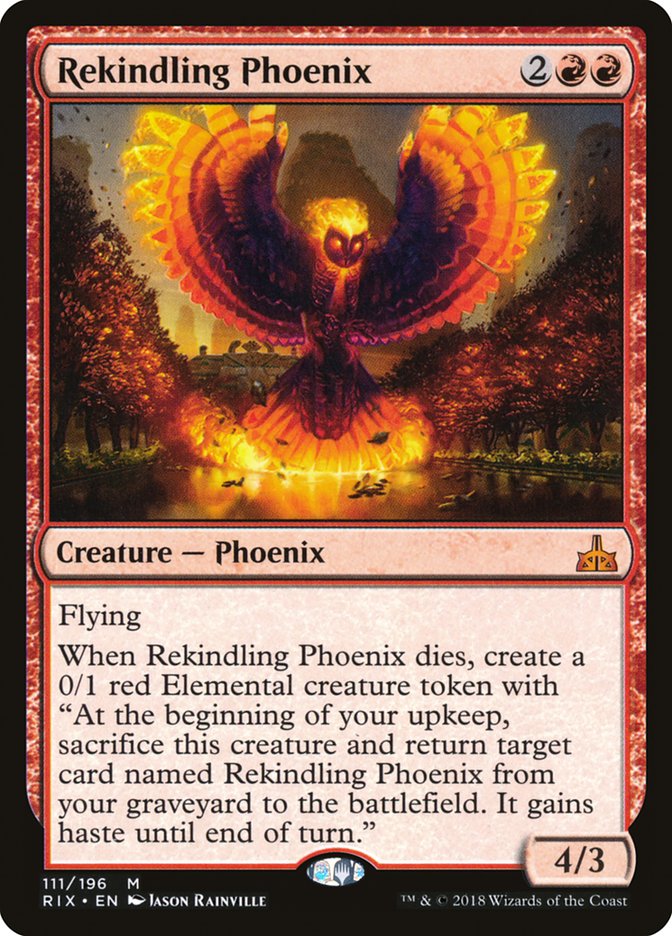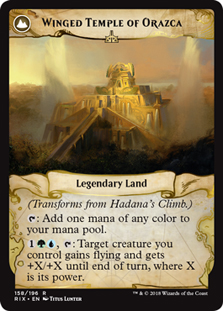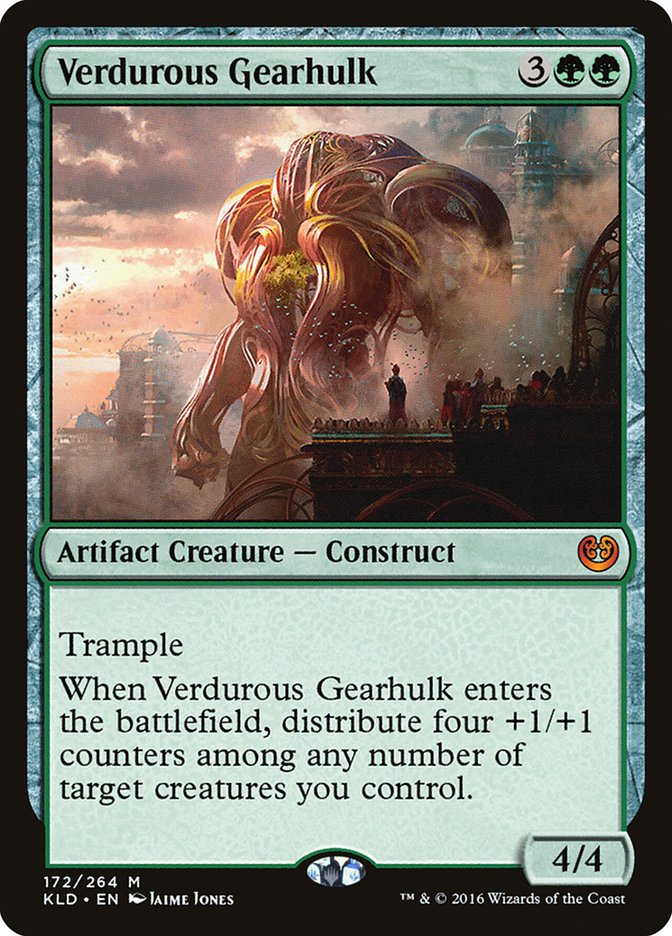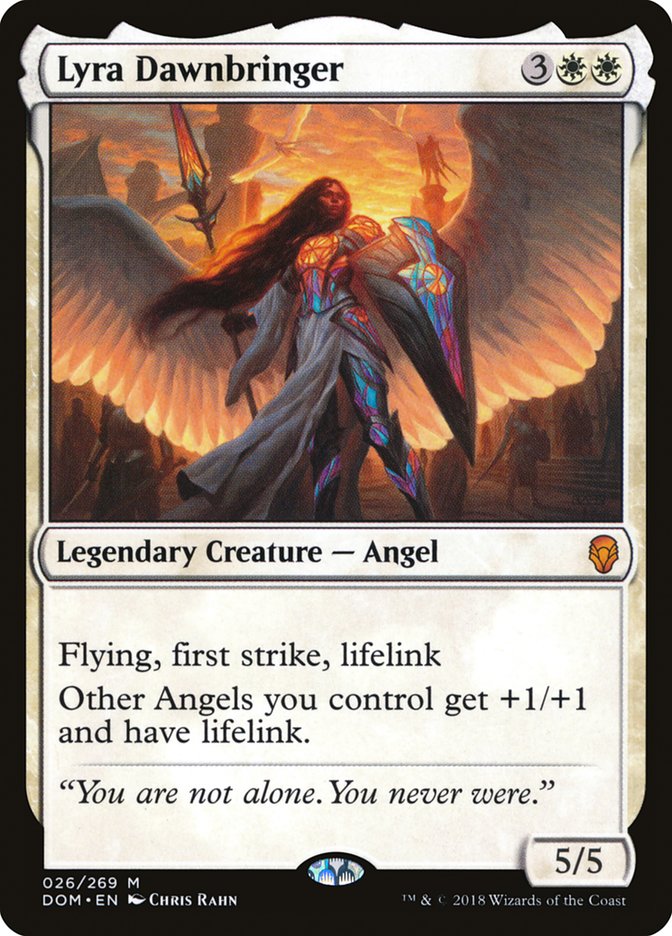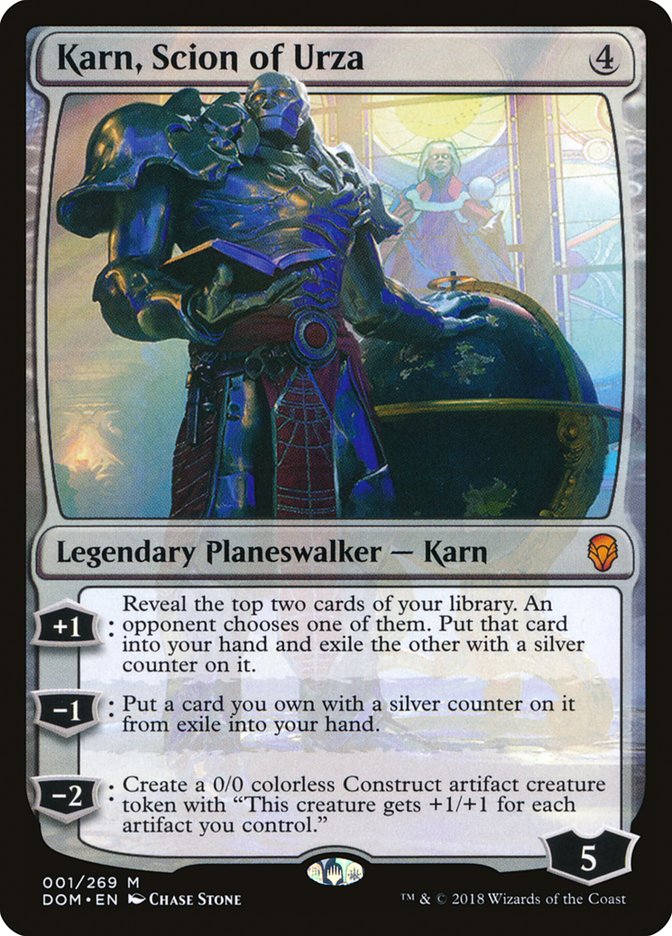Is R/B Aggro the best deck in Standard? Probably not, but it does
make a strong case for itself. Winning Grand Prix Birmingham is well and
good, but you can win a tournament without playing the best deck. It
happens all the time. But placing six copies into the top 8 of a Grand Prix
and nine more copies into the top 32? That’s something special.
Still, Standard can be a very cyclical format and it remains to be seen
whether R/B Aggro can maintain this level of dominance going forward. Dominaria Standard may have only been around for three weeks, but
each of those weeks has seen a new ‘best’ deck emerge from the woodwork. If
this trend continues, I’d say we’re in for a pretty great Standard format.
But let’s set aside the question of the best deck for the time being and
talk instead about the best card in this Standard format. I have a
nomination:
Look, I’ll admit it, I’m pretty biased here. In the almost a year and a
half since the release of Aether Revolt and the printing of
Walking Ballista, I’ve registered Ballista in Standard tournaments far more
often than not. I took a couple of short breaks from the path of the
Ballista, once to play B/W Zombies and once to play U/W Oketra’s Monument.
And honestly, in retrospect I’m not even entirely sure it was correct to
play zero copies of Ballista in the Monument deck.
Point is, I’ve played a lot of Walking Ballista. There’s been times in the
past when I thought Ballista was only okay, and there’s been times when I
thought it was great. Right now, I think it’s the best its ever been, just
truly phenomenal. Case in point: it’s everywhere.
The number of different archetypes playing Walking Ballista right now is
truly staggering. Not only is it seeing play in last weekend’s breakout
deck, R/B Aggro, it’s being played by the breakout deck of the weekend
before, W/B Aggro. It’s true that the breakout deck of the first week, U/W
Control, refuses to sully itself with any copies of Walking Ballista, but
two of its U/W cousins, both Midrange and Historic, aren’t afraid to
besmirch their good name by associating with some Ballistas.
And that’s only the tip of the iceberg. G/B Constrictor is still alive and
well and never considers going out for the day without the full four copies
of Walking Ballista. Every God-Pharaoh’s Gift deck looking to make use of
Gate to the Afterlife wants Ballista. For the most part, unless you’re
playing Search for Azcanta, Hazoret the Fervent, or Steel Leaf Champion,
you’re probably playing Walking Ballista.
And sometimes even then!
There’s lots of good reasons why Walking Ballista enjoys this level of
ubiquity in the format. If you’re interested in them, check out the tail
end of Todd Anderson’s
article
from last week, right under the picture of our good friend Walking
Ballista. Why you should put Walking Ballista in your deck is a fascinating
question…but not one I’m particularly interested in at this moment.
No, what I want to focus on is what to do with the Walking Ballistas I draw
during the game. Ballista is the most flexible Standard card I’ve had the
pleasure of playing with in a long time. Ballista can basically do
anything you want it to, but like all highly flexible cards that aren’t
immediately banned, it can’t do everything you want it to. Time
after time, you’re going to have to decide what the right role is for your
Ballista to play this game, and every time you decide wrong you’re probably
going to lose the game. That’s a lot of pressure on a decision with so many
options but don’t fret, what follows is my fifteen months in the making
guide to everything you can do with a Walking Ballista and when to do it.
Target Acquired
Let’s start with the most common use case of Walking Ballista: killing
creatures. Actually, let’s zoom in a little further than that and start
with the most common type of creatures to kill: X/1s.
Toolcraft Exemplar and Veteran Motorist may not be as popular now as they
once were, but they were the cards that originally convinced me of the
power of Walking Ballista. I vividly recall playing against a Mardu
Vehicles opponent a year ago who played a turn 2 Veteran Motorist against
me. I remember looking down at my hand, seeing my Walking Ballista, and my
whole game plan just instantly clicking into place.
The key thing to realize about using Walking Ballista against these small
creatures is that you don’t want to trade your Walking Ballista straight-up
for their small aggressive creature. Sometimes times are tough and you have
to, but for the most part Walking Ballista is far better than that. After
all, if they play one copy of Toolcraft Exemplar in their deck, it’s very
likely they play four, and a lot of other X/1s to boot. You can do better
than trading your Walking Ballista for a single creature.
When my opponent leads on an aggressive X/1, I’m looking for ways to be
able to cast my Ballista for X=2, eat their X/1, and still have a Walking Ballista on the battlefield. Because their
deck is very likely to contain many more X/1s, it’s probable that what’s
left of my Ballista will eventually trade for another of their creatures or
force them to use a removal spell, even if I never spend any more mana on
it.
Generally, this means looking for ways to get to turn 4 without taking too
much damage from their aggression. Presenting blockers that they must use
removal spells on instead of developing their battlefield is one way to do
this, another is holding up removal for any threat they play with more than
one point of toughness. You’ll feel very good the first time you Fatal Push
an attacking Heart of Kiran on their turn 3, then untap and play a X=2
Walking Ballista that gets to mow down a Toolcraft Exemplar and stick
around.
These two are also prime Ballista targets, but ones that are substantially
harder to slow roll your Ballista against for value. Against Glint-Sleeve
Siphoner I will generally snap off the X=1 Ballista as soon as they are
threatening to draw a card if they untap. Them getting a free card negates
the value I hope to receive down the road from keeping my Ballista around,
and Glint-Sleeve Siphoner decks aren’t known for their plethora of X/1s.
Bomat Courier is a different story. In general, I try very hard to not just
trade Walking Ballista for Bomat Courier, but the risk in waiting isn’t
that the Bomat Courier might deal you too much damage, it’s that it might
build up too many cards. If they get to empty their hand and crack their
turn 1 Bomat Courier before you kill it with a Walking Ballista, you’ve
messed up and probably lost the game.
You need to watch for the point where cracking their Courier will be
beneficial to them and pull the trigger on your Ballista the turn before
that point is reached whether you’ve gotten to four mana or not. Typically,
if you are on the play and they keep seven cards, you’ll be fine to wait
until turn 4. On the draw or when they mulligan, things get harder and you
need to pay careful attention.
No, Walking Ballista can’t kill Hazoret the Fervent, but squeaking all the
value you can out of your Ballistas can play an important role in beating
Hazoret without ever removing it. Look, if a Red Aggro deck is attacking
you with a Hazoret and you don’t have a Vraska’s Contempt or a Cast Out or
some other similar card, you’re in a lot of trouble. Your only hope is to
race and odds are high that the only way that will work is if you manage to
chump block Hazoret a few times. Enter Walking Ballista.
Let’s say you declined to use your Ballista for X=1, instead opting to take
three damage from the Bomat Courier they played turn 1. Ouch. But then on
turn 4 you play a Walking Ballista for two, kill the Bomat Courier, and
pass. They slam Hazoret and alpha you, and you get to block Hazoret and
then kill a Earthshaker Khenra before damage. Not only did you get to kill
two creatures instead of one, you essentially gained four life on the
exchange. Whenever possible, hold your Walking Ballista to do more than
kill a single creature.
The big interaction with Rekindling Phoenix is that Walking Ballista is
very good at killing the Elemental token generated by the Phoenix’s death,
thus killing the Phoenix for good. This means a Walking Ballista with four
counters can permanently end a Phoenix, but that’s not a very typical play
pattern. If you ever do go for that play, keep in mind that a removal spell
on your Ballista with the Elemental creation trigger on the stack will save
their Phoenix.
No, the ideal play pattern when playing Walking Ballista against Rekindling
Phoenix is to offer your opponent trades or opportunities to chump block
with their Phoenix, and after they take it, slam the Ballista in your
second main phase to eliminate the Elemental token. Indeed, the power level
of this sequence is high enough that you can often just chump attack into a
Phoenix while playing a Ballista deck and they will be forced to just let
it through, scared of that main phase two Ballista from you.
No comprehensive guide to Walking Ballista would be complete without
discussing how Ballista battles play out. The key thing to keep in mind is
that your Ballista needs to be two counters bigger than an opposing
Ballista for it to come out of the battle alive. Always announce and
resolve your pings one at a time, as getting the damage marked on the
opposing Ballista is pivotally important since each point of damage
prevents them from using a counter.
One last note on sequencing before moving away from killing creatures:
don’t play Walking Ballista onto an empty battlefield in the early or
midgame. If there’s one lesson to be learned from all I’ve said in this
section, it’s that it is trivially easy for Walking Ballista to do better
than trade for a single card and you should not give your opponent
opportunities to let that be all it does.
If you play a X=2 Ballista while your opponent controls a two-toughness
creature, if your opponent decides to use a removal spell on your Ballista
you get to kill their creature. If no such creature exists, all you get to
do is deal two damage to their face, which is not the extra value you were
looking for.
Synthesizing all of this together, it becomes clear that playing Walking
Ballista on turn 2 should be rare. In general, you only want to do so if
you are trying to set up something, whether it be a Rishkar, Peema Renegade
for your turn 3 or a trigger on the Toolcraft Exemplar you cast on turn 1.
Sometimes if your hand is looking very mana-starved and you have no other
option for turn two you’ll cast it, but most of the time, I would rather
not use my mana at all that turn than deploy Ballista for no reason.
Big Machine on Campus
Let’s move on to the fun stuff: attacking your opponent with a 5/5 or
bigger Walking Ballista. Well, fun in the Timmy kind of way. I personally
tend to have more fun eating three of my opponent’s creatures at once with
my Walking Ballista, but there’s certainly a pure kind of joy in watching
your reasonable removal spell become the biggest creature on the
battlefield.
I win a lot of games with Walking Ballista attacks, and I feel like my
opponents are often a little surprised. The math’s a little tricky to get
your head around, but a piece of cake once you get it. When unblocked,
Walking Ballista can essentially be worth twice it’s power in damage. You
hit them, then you remove all the counters and hit them again.
This means that if you’re late in a game and cast a 4/4 Ballista off the
eight lands you have on the battlefield, that Ballista is worth twelve
damage next turn if gets to attack unhindered. Why twelve? Don’t forget
that you can spin Ballista twice with those same eight lands, making it a
6/6 before damage and then removing all the counters to six them again.
Side note: using Winged Temple of Orazca on a Walking Ballista essentially
makes its hit worth three times its power instead of double. Don’t make the
mistake of thinking it’ll end up as four times. Having a Walking Ballista
on the battlefield means casting a Verdurous Gearhulk can be worth up to
eight points of haste damage instead of just four, ten if there’s a Winding
Constrictor in play as well.
Now for more complicated combats. When pushing for lethal, Walking Ballista
is always worth at least the number of counters on it, even if blocked. You
must be sure to remove the counters before damage, as you won’t be able to
use some after damage is assigned. These combats can be complicated, so
make sure to think all their block permutations through. I have both
surprised people with Ballista lethals and watched opponents miss Ballista
lethals against me many times. The math is weird and ungainly, and
complicated immensely by the ability to spend four mana pumping Ballista
but learning to do it quickly and accurately is hugely beneficial.
Because of Walking Ballista’s huge burst potential when attacking, getting
extra counters on it is closer to exponentially beneficial than additively.
When you get Ballista up to 5/5 in a game that was at all normal, it starts
being a must block threat every turn. This means you will get to eat
creatures with your Ballista for free, without removing any counters at
all. Counters past the third are often very, very threatening and should be
highly valued.
When you get a Ballista to this point, your opponent will often start
thinking about lining up many blockers against your attacking Ballista.
Again, the math is weird. Essentially, every one of your opponent’s
creatures is worth the smaller of their power and toughness stats
when fighting against your Ballista. If their power is greater than their
toughness, you can simply remove counters on your Ballista equal to their
toughness to kill that creature and remove it from combat, effectively
taking damage from it equal to its toughness. It’s really hard to
successfully multi-block a huge Ballista.
Often, getting a huge Walking Ballista will end with you being able to use
it to take out a huge threat that you would otherwise have to spend one of
your few premium removal spells on. It’s very hard to race a Lyra
Dawnbringer, even with a large Walking Ballista. I find that the general
play pattern when they cast a Lyra into your large Ballista is to get one
more attack in, then immediately kill the Lyra. You’ll have a small
Ballista again, but you weren’t winning that race.
Glorybringer’s a much more awkward one. Yes, the card’s raceable, and given
Ballista’s damage potential, it’s a race you’ll likely win. But let’s
consider the scenario where you have a 5/5 Walking Ballista. They play
Glorybringer and you let them go to combat. They attack and exert,
targeting your Walking Ballista. What do you do?
If you let the damage resolve, they can now point a Magma Spray or a
Lightning Strike at your Walking Ballista and finish the job, and you won’t
be able to trade for the Glorybringer anymore because four damage is marked
on your Ballista. You get one ping. You can sidestep this by killing
Glorybringer in response to the exert, but then they don’t have to use a
burn spell and you may have traded your Ballista for Glorybringer for no
reason.
The right play most of the time in even games will be to kill Glorybringer
before letting it attack. They still get to use Magma Spray to finish off
your Ballista, but you couldn’t stop that combination anyway, and this way
at least you get both of their cards out of the deal.
The last thing to keep in mind about late game Walking Ballistas is that
they represent up to four burn spells in the deck, waiting to be drawn and
finish the game. We’re used to this dynamic against red decks, but many
Walking Ballista decks are in colors that don’t normally get to have burn
spells. When playing against Walking Ballista decks, you can’t go too hard
on using your life total as a resource. If you let yourself fall to three,
a Walking Ballista off the top on six mana will end you. Try and stay above
four for sure, five if possible. You can, of course, go lower if doing so
will enable you to end the game in short order.
This is also something to remember when playing a Walking Ballista deck. If
you’re starting to fall behind in a game but have one turn where you can
throw away a bunch of resources to get them into Ballista range, you can
set yourself up to have live draws to win the game. I’ve won many games by
putting just enough pressure on my opponent to get them into range and then
sitting back and playing a normal value-oriented game of midrange Magic
until I draw one of the I-win Ballistas waiting in my deck.
Keeping Chandra and Teferi in Check (Karn too, kind of)
We’ve talked about using Walking Ballista to kill creatures and players,
now it’s time to discuss its role in fighting planeswalkers.
The math involved in using Walking Ballista to attack planeswalkers is
covered in the previous section. You’re a lot sadder about removing the
last counter from your Ballista to kill a planeswalker than you are when
it’s to kill a player, but it’s still worth doing. The numbers involved
will generally be smaller, as planeswalkers tend to come down long before
huge Ballistas are a possibility and that’s a problem.
Walking Ballista is not very good at fighting high loyalty planeswalkers
like Karn. If your opponent plays a Karn on turn 4 and pluses him to six
loyalty, the only way Walking Ballista is going to be able to deal with
that Karn within a single turn cycle is if you were on the play, cast
Walking Ballista for X=2 on your turn 4 into an empty battlefield, and then
spend your whole turn 5 spinning Ballista and trading it for Karn. That
does not strike me as a good exchange, although it’s one I would make every
time in that spot. I just don’t want to be in that spot.
Point being, you don’t want Walking Ballista to be your A plan against
planeswalkers. That’s good, because we don’t want to play our Walking
Ballista early for no reason anyway. You know what Walking Ballista is good
at? Finishing the planeswalker KO that the rest of your creature assault
force started.
Imagine a game where on the draw, you play Heart of Kiran and Scrapheap
Scrounger on turns 2 and 3. Your opponent plays a couple of creatures of
their own and then slams a Karn on turn four. Heart of Kiran can only get
through for four and they have ground blockers for your Scrounger, so even
if you have a creature in hand that can crew Heart, you can’t kill Karn.
Unless, of course, you have Walking Ballista. You use Heart to attack Karn
for four, cast Ballista for X=2, and finish the job. Look at how much
better this exchange was than the previous one where Ballista killed Karn
alone. We were on the draw here, we didn’t have to sink two turns into
trading away our Ballista, and we were able to kill Karn through blockers
on the ground.
Of course, the sequence could be even better. If their planeswalker was a
Chandra, Torch of Defiance rather than a Karn, you don’t even have to lose
your Walking Ballista to get the planeswalker off the battlefield. Ditto
for Teferi, Hero of Dominaria, although the turns don’t line up and we have
to be very scared of the two mana they will have up.
Walking Ballista also does a very good job of keeping the minus abilities
on both Chandra and Teferi in check. Using either of those minuses on the
turn those planeswalkers enters the battlefield leaves them with just one
loyalty counter, easy pickings for a Walking Ballista. Ballista is an
excellent card against U/W Control, and you’ll often see Teferi come down
and target a moderate sized Ballista. First counter goes at Teferi, next
few to face. You must leave one counter though, as putting your best card
third from the top is worth way more than a single point of damage.
The takeaway from the planeswalker discussion is a reinforcement of earlier
points: hold your Ballistas when possible. Walking Ballista is slow to grow
and doesn’t line up well with the loyalty numbers on up-ticking
planeswalkers in the midgame. It’s great at finishing off planeswalkers and
punishing planeswalkers that dare to minus, two roles that it can do better
from your hand than the battlefield.
Alright, maybe trying to get through everything you can possibly do with a
Walking Ballista was a tad ambitious. I’ve covered the general stuff and
the principles at work in most Ballista scenarios, and I’m all out of
space. Let me know if you’d like a part two about Walking Ballistas role in
common matchups, both how it differs based on the Ballista deck in question
and what it’s looking to accomplish against every deck.



